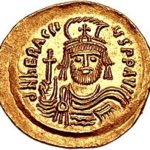
Pope Honorius I
THE MULTITUDE of theological errors and evil laws that have emanated from the Vatican II popes over the past fifty years — and that is exponentially increasing during the madcap reign of Bergoglio — has prompted many traditionally-minded Catholics to seek out ways to reconcile the notion of papal authority with the obvious destruction wrought by those in our day who claimed to wield it.
Sedevacantists like myself settled on the following explanation a long time ago: the very errors and evils officially sanctioned by the Vatican II popes demonstrate that they never truly obtained papal office (or authority) in the first place, and were therefore false popes. (For an explanation, see Sedevacantism: A Quick Primer)
Others — be they Novus Ordo conservatives, neo-traditionalists within the Vatican II establishment, or traditionalists of the Recognize-and-Resist (R&R) variety — shied away from this conclusion. They sought to reconcile “recognizing” the V2 popes as true Successors of Peter with simultaneously “resisting” them — minimizing any obligation to adhere to the teachings of the V2 popes, to observe their laws, or in practice, to submit to their authority.
To achieve this end and to negate the logical appeal of sedevacantism, the conservative/neo-trad/R&R camp sought to demonstrate two things:
- Since ordinary papal teaching lacked the “infallible stamp” that the rare ex cathedra papal pronouncement possessed, Catholics had no obligation whatsoever to submit or adhere to it. Ergo, you’re free to ignore Bergoglio’s (or for that matter, Paul VI’s) teachings and laws.
- Some popes in the past (Nicholas I, Vigilius, Honorius, Liberius, Celestine III, John XXII, Alexander VI) were heretics, but nevertheless were always recognized as true popes. Ergo, a pope can teach heresy and still remain pope — take that, wicked sedes!
 This is old stuff that the “right” subjected to constant recycling, even before Bergoglio’s Laudato Sì, and it always manages to float back, like gas from the landfill. I refuted point (1) in section 1 of 9/11 for the Magisterium, as well as in the introduction to my recent article, The Errors of Athanasius Schneider. I have refuted point (2) in a variety of articles listed in section 3 of my sedevacantist primer — and in so doing, please note, I have always pointed out that it was the Protestants, the Gallicans, and other haters of papal authority who raised these charges of “papal heresy” and were roundly trounced by an array of Catholic dogmatic theologians.
This is old stuff that the “right” subjected to constant recycling, even before Bergoglio’s Laudato Sì, and it always manages to float back, like gas from the landfill. I refuted point (1) in section 1 of 9/11 for the Magisterium, as well as in the introduction to my recent article, The Errors of Athanasius Schneider. I have refuted point (2) in a variety of articles listed in section 3 of my sedevacantist primer — and in so doing, please note, I have always pointed out that it was the Protestants, the Gallicans, and other haters of papal authority who raised these charges of “papal heresy” and were roundly trounced by an array of Catholic dogmatic theologians.
For the conservative-neo-trad-R&R camp, however, the historical case that seems both to provide a refutation of sedevacantism and to demonstrate the validity of points (1) and (2) is the case of Pope Honorius. From this, we are supposed to draw by analogy a principle for a course of action vis-à-vis Bergoglio and all the Vatican II popes that will allow one to recognize them as popes, but never, ever submit to them.
I dealt with the case in my lengthy article on Bp. Schneider, but since Honorius always seems to pop up in discussions of papal authority, I’ve been asked to sum up my arguments as a separate article.

Emperor Heraclius
1. General Background. Pope Honorius I (625–638) reigned during the great controversy over the Monothelite heresy (=Christ had only one will, the divine). Around 634, he was approached by Sergius, Patriarch of Constantinople, who was attempting to resolve the dispute and pacify all sides in order to please the emperor Heraclius. Honorius responded to Sergius with several letters dealing with the controversy. Their contents became public only after the death of Honorius, and led to his being accused, variously, of either being a heretic himself, or at least, of being soft on heresy.
In 681 the Third Council of Constantinople posthumously condemned and anathematized Honorius, together with several Monothelites, which condemnation was subsequently renewed by the Second Council of Nicaea in 787 and the Fourth Council of Constantinople in 870. The condemnation subsequently made its way into the texts of some ecclesiastical oaths, and the Roman Breviary prior to 1570 portrayed Honorius as having been condemned for heresy.
Nevertheless, despite these condemnations, the Church continued to recognize Honorius as having been a true pope and true successor (albeit perhaps weak) of St. Peter.
Thus the facts in the story of Honorius that everyone agrees upon.

Points of contention!
2. Disputed Facts and Interpretations. But there are countless other facts and complications in this story that church historians and theologians do not agree upon, have interpreted in different ways and, generally, have been fighting over for centuries.
These disputed issues include: whether the texts themselves of Honorius’s letters really prove he was a heretic, or merely that he was “soft” in combatting heresy; how the term “heresy” is to be understood in the various conciliar condemnations, since at the time it did not always have the precise technical meaning it has today; whether the subsequent papal approval of the conciliar acts of Third Constantinople (necessary for their legal effect), approved the condemnation of Honorius for heresy properly speaking, or only cowardice; or whether some of the documents were or contained forgeries, a common problem during the era.
Countless other uncertainties like these muddy the waters, making it difficult not only to arrive at a clear and objective historical account of the Honorius affair, but also to tease out of these complicated events correct theological consequences.
Protestants, Gallicans, rationalists and others, especially in the 19th century, had no hesitations about their conclusions, of course, and they routinely trotted out the Honorius affair as one of their main arguments against papal authority in general, and papal infallibility in particular.
Over the centuries, however, the great Catholic dogmatic theologians, including St. Robert Bellarmine, while often disagreeing among themselves over facts and the documentation in the case, refuted at great length the repeated attempts to use Honorius as a cudgel to smash traditional Catholic teaching on the authority of the pope. Their arguments were so successful that by the twentieth century, the standard dogmatic theology manuals usually treated the case of Honorius summarily, in a sentence or two, among the minor objections to the pope’s authority.
(For an overview see The Case of Honorius I, together with a link to a nineteenth century work by Fr. [later Cardinal] Louis-Nazaire Bégin.)

R&R apologist Christopher Ferrara
3. Honorius and the Traditionalists. After Vatican II, nevertheless, traditionalist writers of the “recognize and resist” variety, such as Michael Davies and Christopher Ferrara — perhaps unaware that they were keeping some utterly disreputable theological company — tried to resurrect Honorius as a killer analogical argument against both sedevacantism (which is based on the theological teaching that a public heretic can neither obtain nor retain papal office or authority) and against the obligation to assent to ordinary papal teaching. The conclusion they wanted to be drawn was that since Honorius was a heretic and the Church still recognized him as a true pope, so too, a pope who is a heretic does not lose his office and may safely be ignored.
Nearly fifteen years ago, it took me only a few sentences to shoot down this shaky analogy in my article Mr. Ferrara’s Cardboard Pope (see #11).

Keeping him safe from sede kryptonite!
4. Honorius in the Age of Bergoglio. Honorius, though, started surfacing again in conservative and neo-trad attempts to explain Bergoglio, such as Dr. Roberto di Mattei’s 2015 article Honorius I: The Controversial Case of a Heretic Pope. In these articles, wherever Catholic historians and dogmatic theologians in the past disagreed over facts, documentation, or the analyses thereof, these conservative and neo-trad polemicists always picked whichever position which seemed the most damaging to Honorius — and therefore the most favorable to their own anti-sedevacantist, ignore-the-pope position.
This is the same procedure that Bp. Schneider recently followed with Honorius, in order to push readers to the following conclusion:
“Pope Honorius I was fallible, he was wrong, he was a heretic… [The three successive ecumenical councils, despite the fact that they] excommunicated Pope Honorius I because of heresy, … did not even implicitly declare that Honorius I had lost the papacy ipso facto because of heresy. In fact, the pontificate of Pope Honorius I was considered valid even after he had supported heresy in his letters to Patriarch Sergius in 634, since he reigned after that another four years until 638.”
I am sure that Bp. Schneider thought that this argument was really powerful and original (as, no doubt, did many of his conservative and neo-trad readers). But had he done even a bit more research, he would have discovered that the argument had already been made and summarily shot down a long time ago.
 5. A Faulty Analogy. For like countless trad controversialists of the ’70s, ’80s, ’90s and ’00s, His Excellency wanted us to derive by analogy from this complex series of events two general theological principles:
5. A Faulty Analogy. For like countless trad controversialists of the ’70s, ’80s, ’90s and ’00s, His Excellency wanted us to derive by analogy from this complex series of events two general theological principles:
- The Honorius case demonstrates that Catholics have no obligation to assent to ordinary papal magisterium.
- The Honorius case defeats the general principle laid down by St. Robert Bellarmine’s (and relied upon by sedevacantists) that a heretical pope automatically loses his office.
Both of these analogical arguments and the principles derived therefrom are false, simply because the common properties needed for any analogy to “work” are completely absent from these analogies.
A. Catholic historians and dogmatic theologians hotly disputed factual issues in the Honorius case (whether the letters showed he was guilty of heresy or merely soft on it, the sense of the term “heresy,” the meaning of the conciliar condemnations, etc.); this renders the factual foundation of the analogies unreliable to begin with.
Why? Because one can have no certitude whatsoever about essential common properties between the two things we are comparing: the Honorius case and Bellarmine’s loss-of-papal-office teaching.
As regards questions of fact alone, therefore, the basis for the analogy simply disappears.

A LOST property, too!
B. The disputed letters were NOT PUBLIC; and it is only PUBLIC heresy that prevents a heretic from obtaining or retaining papal office or authority.
The theologian Hurter and others say it is certain that: “the letters of Honorius were unknown [ignotae] until the death of the Pontiff and that of [the Patriarch] Sergius.” (Medulla Theologiae Dogmaticae, 360.)
This one fact alone destroys the Honorius case as an argument both against the theologians after Bellarmine and against sedevacantism, even if one were to concede that the contents of Honorius’s letters were heretical. For it is only public heresy that takes someone out of the body of Church, and in the case of the papacy, it is public heresy that prevents the heretic from obtaining or retaining papal office. Private heresy in a pope, on the other hand, has no such effect.
The existence of public heresy in a pope is the very foundation for the principle Bellarmine lays down, and it is the existence of public heresy in the Vatican II popes to which sedevacantists apply Bellarmine’s principle and draw their conclusion.
So the analogy that conservatives, neo-trads and the adepts of R&R wish to draw with Honorius is simply not apposite — or in plain English, is just plain dumb — based as it is on a phony apples-to-oranges comparison.
C. The disputed letters were not public; they may not therefore be adduced as an analogical argument against the obligation of Catholics to give “the assent of the intellect” to what the pope teaches through his authentic ordinary magisterium.
Papal letters that remain hidden and unknown throughout the course of a pontificate and only surface after a pope dies are not magisterium at all. The “teacher” (magister) was dead for fifty years — in this case, until 680 — and there was no one in the classroom.
And in the present discussion, it is the public teachings (either by word or by deed) of the Vatican II popes that faithful Catholics object to as contrary to Catholic faith and morals — the errors and evils these men have openly and manifestly attempted to impose upon the universal Church in every part of the world. This they have done on thousands of occasions through their countless encyclicals, decrees, instructions, decrees, speeches, discourses and public acts.
So, as with the loss-of-papal-office argument, the Honorius analogy lacks yet another common property for the principle it attempts to prove.
 D. The principle upon which Bellarmine and sedevacantists base their theological position is derived from the data of revelation — faith is necessary for membership in the Church — and on the face of it therefore offers a degree of theological certitude that cannot be obtained from a mere (and in this case, factually questionable) analogy.
D. The principle upon which Bellarmine and sedevacantists base their theological position is derived from the data of revelation — faith is necessary for membership in the Church — and on the face of it therefore offers a degree of theological certitude that cannot be obtained from a mere (and in this case, factually questionable) analogy.
The argument from analogy (comparing the common properties between two things) can never provide certitude, only probability. Only significant resemblances have value in an argument of this type (Bittle, Science of Correct Thinking [1950], 348), and there are none here.
For in the case of Honorius, we have clearly demonstrated that the fundamental facts of the analogy are disputed, and that the required common properties do not exist. Moreover, even assuming that the fact were true, they could still not provide an even remotely credible analogical argument against Bellarmine, sedevacantism and the teaching authority of authentic papal magisterium.
* * * * *
THUS the answer to our question: No, the Honorius affair does not refute either (1) the general obligation Catholics have to adhere to authentic papal magisterium, or (2) the principle behind sedevacantism that a public heretic cannot obtain or retain papal authority.
Thus conservatives, neo-trads and R&R followers are left with the same dilemma they have faced for fifty years: How to reconcile, on one hand, the obvious errors and evils officially taught and sanctioned by the V2 popes, and on the other, the indefectibility and infallibility of Christ’s Church, which by Our Divine Lord’s promise can give neither error nor evil. One side of the dilemma must give way, my friends — it’s either men with no authority who have defected from the faith or it’s a defected Church where Christ’s promise has become void. But for those with faith, this should be no dilemma at all.